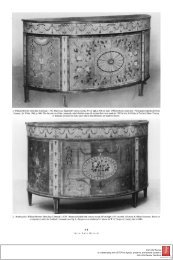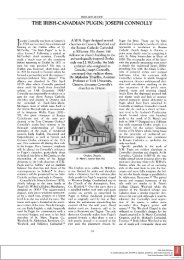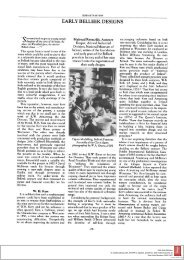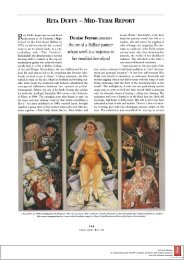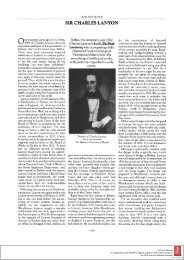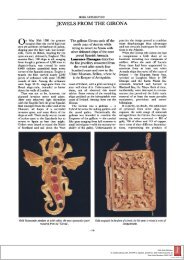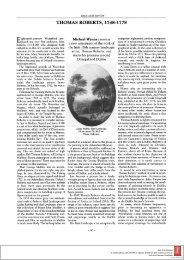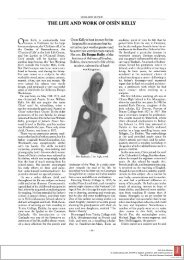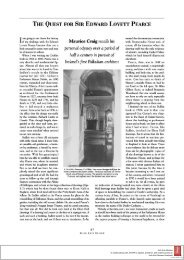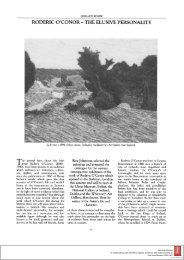CECILY BRENNAN - Irish Arts Review
CECILY BRENNAN - Irish Arts Review
CECILY BRENNAN - Irish Arts Review
Create successful ePaper yourself
Turn your PDF publications into a flip-book with our unique Google optimized e-Paper software.
Cecily Brennan, one of the foremost<br />
<strong>Irish</strong> landscape painters of her<br />
generation, seldom - if ever - paints<br />
out of doors. This, quite simply, is<br />
because she believes that too great a<br />
concern with naturalism would jeopard<br />
ize the expression of the 'sense of place'<br />
that is central to her work. But Bren<br />
nan's landscapes are not imaginary like,<br />
say, Michael Mulcahy's, which use the<br />
'props' of a given environment to flesh<br />
out the artist's psychological dramas.<br />
The thrust of Brennan's painting is<br />
founded on a confrontation between<br />
subjective vision and physical reality.<br />
The strength of her images, particularly<br />
in the last year or two, stems from the<br />
fact that the viewer cannot readily<br />
determine where ideas and feelings end<br />
and the natural landscape begins.<br />
Other young artists - Therese Oulton<br />
and Peter Lewis in England, for example<br />
- are quarrying the same vein, and there<br />
is a growing number of landscape paint<br />
ers whose work is as much rooted in<br />
personal experience as in observation of<br />
nature. This attitude, of course, is far<br />
from novel; in Ireland, artists like Barrie<br />
Cooke, Sean MacSweeney and Patrick<br />
Collins capture moods and essences at<br />
least as convincingly as they depict<br />
specific locations. But Brennan's two<br />
series of paintings are thoroughly in<br />
dividual; both the early Wicklow land<br />
scapes, which are about open spaces and<br />
the way man has effected changes in<br />
wild terrain, and the more recent'Paint<br />
ings from a Rhododendron Garden',<br />
which investigate the artist's responses<br />
to a particular place, are stamped with<br />
her own personality. The latter evoke a<br />
sense of passion, desire, and a need for<br />
completeness; the Wicklow views are<br />
suggestive of estrangement and alien<br />
ation. They are all, however, related to<br />
aspects of the Romantic tradition.<br />
Yet the demands that Brennan's work<br />
make of the viewer are decidedly of our<br />
own time, and her images cause us<br />
to question our personal assumptions<br />
and preconceptions. Most of us, for<br />
instance, (certainly the majority of<br />
those who look closely at her paintings)<br />
are alienated from the land. We don't<br />
view the land in the same way as the<br />
farmer or the agricultural labourer<br />
would. To urban man, the landscape is<br />
a complex of associations, some of them<br />
mundane and straight-forward, others<br />
sentimental and mythical. It is the last<br />
IRISH ARTS REVIEW<br />
<strong>CECILY</strong> <strong>BRENNAN</strong><br />
<strong>Irish</strong> art historian,<br />
John Hutchinson, writes<br />
about the work of the painter<br />
Cecily Brennan which has<br />
attracted much attention since<br />
the outstanding critical and<br />
commercial success of her first<br />
exhibition in Dublin only<br />
four years ago.<br />
The artist in her studio.<br />
of these which neo-Romantic landscape<br />
painters, of whom Cecily Brennan is<br />
one, choose to explore.<br />
Brennan's first exhibition, at the<br />
Project Gallery in 1982, launched her<br />
career with unusual panache. Not alone<br />
was the show a critical success, but all<br />
the paintings and drawings were sold,<br />
clearly on the basis of the quality of<br />
the work, not on her reputation. The<br />
landscapes, many of them very large,<br />
were all views in Co. Wicklow, where<br />
the artist was then living; most were<br />
'bird's-eye' views, seen from a distance<br />
and from a great height. This made<br />
them oddly reminiscent of those early<br />
eighteenth century landscapes whose<br />
topographical clarity and 'God's-eye'<br />
perspective reflected the landownerse<br />
ownership and control of the terrain.<br />
And there was another parallel with the<br />
past: Brennan, like her Georgian pre<br />
decessors, showed the way in which the<br />
landscape had been changed by man.<br />
The eighteenth century paintings were<br />
designed to demonstrate how the land<br />
-41<br />
owners had improved the land, taming it<br />
and bringing it under enlightened super<br />
vision, but Brennan was concerned with<br />
the interaction of man and the landscape<br />
- the way nature's 'Romanticism' is<br />
tempered by the ordered 'Classicism' of<br />
turf-cutting, fire-breaks, and Forestry<br />
Commission tree plantations. In her<br />
Wicklow images, these two principles<br />
keep each other in check, neither<br />
dominating the other. In 'Path and<br />
Forest' (1981), nature seems to rebel<br />
against man's imposed order. The<br />
roughly brushed yellow paths 'burn'<br />
with vitality, and the tiny green fir-trees<br />
appear to be about to break their<br />
serried ranks.<br />
At times, these landscapes verge on<br />
the symbolic, in 'Lough Tay (1981),<br />
the lake has a shape that bears some<br />
resemblance to a phoenix, and the river<br />
that feeds it is not unlike a serpent,<br />
which makes the image suggestive of<br />
fertility and rebirth. The large graphite<br />
drawing, 'Forest and Firebreak' (1981),<br />
can even be read as a sexual metaphor;<br />
the lower part, a dense black mat of<br />
trees, split in two by a firebreak, is<br />
gently penetrated by a vertical line of<br />
firs. This huge work, besides foreshad<br />
owing the implied sexuality of her<br />
later paintings, was among the most<br />
innovative pieces in the Project show.<br />
Its scale and vertiginous viewpoint<br />
induce a sensation akin to eighteenth<br />
century 'Sublimity' - although it is<br />
created not by placing a human being at<br />
the foot of a towering peak, but by<br />
situating the viewer far above the<br />
landscape. This was a nice twist of con<br />
vention, repeated throughout the series;<br />
it brings to mind contemporary exper<br />
iences of great height, such as air-traveL<br />
In its monochrome austerity, there is<br />
something decidedly Oriental about<br />
'Forest and Firebreak', despite the ner<br />
vous, scratchy lines so densely applied<br />
that the graphite became shiny.<br />
Although the Wicklow works were<br />
founded on direct perception of nature,<br />
they were also composed of the artistes<br />
responses to the landscape. As such,<br />
they suggested a sense of self-loss<br />
through absorption in space and expan<br />
siveness, an attitude that also has prece<br />
dents in Romantic painting. But when<br />
Brennan left Co. Wicklow and returned<br />
to live in Dublin, this characteristic<br />
disappeared from her images. Initially,<br />
the absence of the environment that she<br />
<strong>Irish</strong> <strong>Arts</strong> <strong>Review</strong><br />
is collaborating with JSTOR to digitize, preserve, and extend access to<br />
<strong>Irish</strong> <strong>Arts</strong> <strong>Review</strong> 1984 1987 ®<br />
www.jstor.org
I<br />
.' I - 0*<br />
0 . u.s
9<br />
i<br />
i SN<br />
.1~~~~~~~~~~~1<br />
. x,.*20 .$Y AS." ~ ~<br />
lli1 M L.I
had come to know so intimately, shook<br />
her confidence, for the occasional pic<br />
tures that surfaced at exhibitions after<br />
the Project show were tentative and<br />
indecisive. The majority of them,<br />
inspired by the Iveagh Gardens off St.<br />
Stephen's Green, were low- keyed efforts,<br />
none of them even hinting at the extra<br />
ordinary burst of energy and colour that<br />
sprang from the canvases at her second<br />
solo exhibition in 1985, this time at the<br />
Taylor Galleries.<br />
Cecily Brennan's second show could<br />
scarcely have differed more substantially<br />
from her first. If one of the limitations<br />
of the early work had been its dry,<br />
acrylic paint surfaces, she went to the<br />
other extreme in 'Paintings from a<br />
Rhododendron Garden'. The new pic<br />
tures were uniformly lush in texture,<br />
fluidly covered with oil pigment. But a<br />
more significant innovation was a shift<br />
from an extroverted to an introverted<br />
attitude to her subject-matter. These<br />
landscapes were more abstracted and<br />
internalized than before. The quiet<br />
detachment that characterized the<br />
Wicklow pictures was replaced by a<br />
sensuous relish of colour and form,<br />
which related them distantly to Monet's<br />
joyous Giverny garden paintings. Bren<br />
nan's 'Rhododendron' series is about<br />
growth, passion, and the source of life<br />
itself.<br />
However did the artist set about<br />
achieving this? The paint was brushed<br />
on flatly, each area of the painting flow<br />
ing into another, thus unifying the<br />
image and creating a feeling of ease and<br />
immediacy. Frequently the viewer is<br />
drawn further into the picture, into a<br />
kind of vortex, by means of loose spiral<br />
forms - as in the majestic 'Pathway'<br />
(1985). The colours are softly applied<br />
and warm in hue, often flickering like<br />
flames against a dark background. There<br />
were, admittedly, some formal parallels<br />
with the Wicklow views - the drawings,<br />
with their broken rhythms and 'bird's<br />
eye' viewpoints, were transitional works<br />
- but the overall impression of the<br />
IRISH ARTS REVIEW<br />
<strong>CECILY</strong> <strong>BRENNAN</strong><br />
show was of a new beginning, of a dif<br />
ferent technique being used to express<br />
fresh ideas.<br />
The 'Rhododendron Garden' paint<br />
ings were the result of prolonged<br />
exposure to a single place; they are<br />
about essences, not particulars. And<br />
although they may look free and<br />
instinctive, they are, in fact, reflective<br />
compositions. The images allude to the<br />
subject and are not actually descriptive;<br />
their fluidity extends as much to con<br />
tent as to form. Indeed, once one<br />
begins to examine these paintings close<br />
ly, one is hard put to it positively to<br />
identify a single element they contain.<br />
Brennan's realism (for these pictures are<br />
not just figments) embraces her own<br />
emotions as well as perceptible pheno<br />
mena. The struggle between these two<br />
aspects of her work is captivating when<br />
it is forceful, as it usually is, but it also<br />
accounts for one of her main weakness<br />
es. If the tension between the subjective<br />
and objective slackens, or if it is not<br />
sustained throughout the whole image,<br />
the paintings lapse into merely decora<br />
tive abstraction.<br />
It is revealing, I think, that Cecily<br />
Brennan should have chosen a garden<br />
as a source of inspiration, for in some<br />
respects it was the very opposite of the<br />
natural landscape that fascinated her<br />
before. Yet it can be argued that she<br />
was always as much interested in man's<br />
involvement with the land as with the<br />
mountains and lakes themselves, and<br />
in that sense her absorption in the<br />
rhododendron garden in Howth is an<br />
extension, rather than a reversal, of<br />
her earlier concerns. If a garden is an<br />
example of nature under control, Bren<br />
nan's violates its boundaries; if a garden<br />
is a kind of discreet space between the<br />
intimacy of a home and the threatening<br />
world outside, Brennan's rose-tree<br />
world is the most personal space<br />
imaginable. So the artist's awe of the<br />
power of nature still remains.<br />
Even in the most carefully mastered<br />
gardens the indomitable energy of<br />
-44<br />
nature is at work; horticulture may be a<br />
symbolic attempt to control it, but<br />
unless you resort to drastic violence,<br />
the best you can hope to achieve is a<br />
rough and ready compromise. Brennan,<br />
however, has no time for contrived<br />
conciliations. Her gardens are secret<br />
sources of life, secluded paradises. The<br />
Biblical Eden was a paradise where a<br />
talking serpent brought about the<br />
replacement of the act of creation by<br />
one of generation; it is an unambiguous<br />
lesson about the seductive side of<br />
nature. In contrast, Persian classical<br />
gardens, also known as 'paradises', were<br />
deliberately constructed as erotic enclo<br />
sures. Brennan's'Rhodendron Gardens',<br />
with their womb-like interiors and<br />
colourful flambeaux of flowers, revive<br />
that notion, not overtly, but through<br />
allusion. Translate the mediaeval court<br />
ly images of 'La Dame et L'Unicorne',<br />
with all their repressed sexuality, into<br />
our own age of abstraction and relati<br />
vity, and you might end up with paint<br />
ings such as these. Only now they're<br />
painted by a woman, not by men.<br />
'Paintings from a Rhododendron<br />
Garden', because of their implicit sex<br />
uality, suggest desire, not fulfilment,<br />
absence, not presence. It is fitting, then,<br />
that the predominant motif in the series<br />
is a flame - the pictures are full of<br />
lambent, wavering shapes that are<br />
forever poised on the edge of dissolut<br />
ion. Fire, of course, is tantalizingly close<br />
to being pure energy; although visible<br />
and tangible, it cannot be held or<br />
imprisoned, because flames are the<br />
effect, not the cause of combustion.<br />
And fire is a powerful metaphor. For<br />
instance, as Gaston Bachelard has<br />
observed, fire symbolizes "the need to<br />
penetrate, to go to the interior of<br />
things, to the interior of beings." This<br />
is equally true of 'Paintings from a<br />
Rhododendron Garden', which turn the<br />
key in the gate of a luxuriant 'inner<br />
sanctum'.<br />
John Hutchinson



